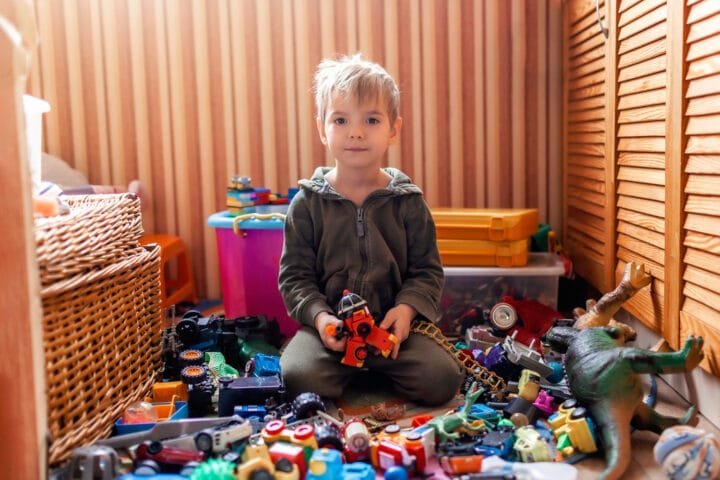“Mommy, There’s a Monster Under My Bed!” – Decoding Childhood Nightmares and Night Terrors (and Saving Your Sanity!)
Have you ever sprung awake to bloodcurdling screams echoing from your child’s room? With your heart pounding, you rush in, prepared to battle dragons or wrestle goblins, only to discover your little one sitting upright, eyes wide with terror, completely unresponsive to your comforting whispers.
Nightmares and night terrors can be relentless sleep thieves for every parent. They leave us feeling helpless, exhausted, and sometimes even a bit fearful. But fear not, fellow warriors of the night! We’re about to dive deep into these spooky sleep disturbances, unravel their mysteries, and arm you with the knowledge to banish those nighttime monsters for good (or at least until the next growth spurt!).
What Lurks in the Shadows? Nightmares vs. Night Terrors
First things first, let’s clarify the differences between nightmares and night terrors. It’s similar to distinguishing between a creepy shadow puppet and an intense horror movie—both can be frightening but in very different ways.
- Nightmares: These are the classic “bad dreams.” They often unfold vividly and bizarrely during REM sleep, when our brains are busy crafting fantastical stories. Your child might wake up in fright, heart racing, and recount a detailed tale of being chased by mischievous gremlins or escaping a hungry T-Rex. Nightmares typically occur in the later part of the night, and thankfully, your little one will likely remember the dream and find comfort in your presence.
- Night Terrors: These are a whole different phenomenon! Imagine your child suddenly bolting upright, eyes wide open but glazed over, screaming and thrashing as if a tiny, terrified demon possesses them. It’s enough to make your hair stand on end! Night terrors happen during deep sleep early in the night and are characterized by intense fear, confusion, and physical symptoms such as sweating, rapid breathing, and even sleepwalking. The scariest part is that they won’t remember a thing in the morning!
To put it simply, nightmares are like playing a spooky video game, while night terrors resemble being trapped inside one. Understanding the difference is crucial because it influences how we respond to these nighttime disturbances.
Why the Nighttime Frights? Unmasking the Culprits
What causes these frightening episodes in our children’s minds? It’s a bit like detective work, as there are several potential triggers to uncover. Some common causes of nightmares and night terrors include:
- Stress and Anxiety: Children can experience stress from various sources, such as school pressures, social challenges, family changes (like having a new sibling or moving to a new house), or even a scary news report they overheard. Just like adults, children process their worries and fears through their dreams.
- Sleep Disturbances: An irregular sleep schedule, insufficient sleep, or changes in their sleep environment (such as a new bed or room) can disrupt a child’s sleep patterns, making them more vulnerable to nightmares and night terrors.
- Fever and Illness: You may have noticed that your child has more nightmares when they are sick. A fever can disrupt their sleep patterns and trigger unsettling dreams.
- Certain Medications: Some medications can have side effects that interfere with sleep and contribute to nightmares. Always consult a doctor if you suspect this may be a factor.
But wait, there’s more! Nightmares and night terrors also have their own unique set of instigators:
- Nightmare Fuel: Spooky stories, scary movies, or vivid illustrations from a favourite book can lead to monster-filled dreams. It’s like giving their imagination a spicy dose of chilli peppers right before bedtime!
- Hidden Fears: Sometimes, nightmares reflect underlying fears and anxieties that your child may not even be consciously aware of. These could include fears of the dark, separation anxiety, or concerns about school and friendships.
- Genetics and Sleep Disorders: Night terrors can sometimes run in families. Additionally, underlying sleep disorders, such as sleep apnea or restless legs syndrome, may increase their likelihood. If your child experiences frequent or severe night terrors, it’s a good idea to consult a doctor to rule out any medical conditions.
Age-Specific Solutions: Battling the Beasts with the Right Weapons
Now that we know our enemy let’s gear up with the right tools and strategies to fight back! Just like we wouldn’t give a toddler a sword to fight a dragon (though that would be pretty awesome!), we need age-appropriate solutions to tackle nightmares and night terrors.
Immediate Responses: First Aid for Frightened Sleepers
Whether it’s a nightmare or a night terror, the immediate response should focus on providing comfort and safety.
- Nightmares: Scoop your little one up in a warm hug and reassure them that you’re there. Validate their feelings by saying, “Oh, sweetie, that sounds like a really scary dream! I’m so glad you’re awake now, and I’m right here with you.” Avoid getting into a detailed discussion about the nightmare’s content, as this may only fuel their fear. Instead, focus on calming them down and helping them feel safe.
- Night Terrors: This is where things can get tricky. Your child might seem awake, but they’re actually still in deep sleep. Please resist the urge to shake them awake or try to reason with them; it won’t work! Instead, focus on ensuring their safety. Gently guide them back to bed if they’re wandering around, remove any potential hazards, and speak in a calm, soothing voice. You might say, “You’re safe, sweetheart. Mommy’s here.” Eventually, they’ll drift back to sleep, and you can breathe a sigh of relief.
Long-Term Strategies: Building a Fortress of Peaceful Slumber
Now that we’ve tackled the immediate crisis let’s build some long-term defenses against those pesky nighttime intruders. Here’s where we tailor our approach to different age groups:
Toddlers and Preschoolers (2-5 years): The “Cuddle and Comfort” Brigade
- Routine is Key: The power of routine cannot be underestimated! A consistent bedtime routine acts like a magic spell for toddlers and preschoolers. Keeping it simple, predictable, and calming—think bath, book, bed—signals to their little bodies that it’s time to wind down and prepare for sleep.
- Comfort Objects: A beloved teddy bear, a soft blanket, or a favourite stuffed animal can be a powerful ally in combating nighttime fears. These comforting “friends” provide a sense of security, helping your little one feel safe and loved, even when you’re not right beside them.
- Nightlights and Monster Be-Gone: A soft nightlight can help chase away scary shadows and imaginary monsters lurking in the corners of their room. You might even create a “monster spray” together—a simple spray bottle filled with water and a few drops of lavender essential oil—to banish those imaginary creatures before bedtime.
- Simple Explanations: If your child wakes up from a nightmare, offer simple explanations. You can say, “That was a bad dream, sweetie. It’s gone now, and you’re safe.” Avoid going into too much detail, as their imaginations are still very active and may conjure up even scarier scenarios.
Early Childhood (6-8 years): The “Dream Warriors”
- Open Communication: Encourage your child to talk about their fears and nightmares. Create a safe space where they feel comfortable sharing their worries without judgment. Active listening is crucial; let them express themselves fully and acknowledge their feelings.
- Creative Coping Mechanisms: Introduce fun and creative ways to cope. For example, use “dream catchers” to capture bad dreams, “worry dolls” to whisper their fears to, or have them draw pictures of their nightmares and then tear them up to symbolically “destroy” the scary images.
- Empowerment Through Choice: Offer choices within the bedtime routine to give your child a sense of control. For instance, ask, “Would you like to read this book or that one?” or “Do you want to wear your pajamas with stars or dinosaurs?” These small choices can significantly reduce anxiety and promote a sense of agency.
Older Children (9-12 years): The “Mindfulness Masters”
- Relaxation Techniques: Teach your child relaxation techniques, such as deep breathing exercises, progressive muscle relaxation (tensing and releasing different muscle groups), and visualization (imagining peaceful and calming scenes). These tools can help them manage anxiety and promote restful sleep.
- Problem-Solving Skills: Help your older children identify possible triggers for their nightmares or night terrors. Is it stress about school or worries about friends? Once they pinpoint the source, they can work together to develop strategies to address the issue.
- Journaling for Emotional Release: Encourage them to write down their nightmares or worries in a journal before bed. This practice can help them process their emotions and release any pent-up anxieties. Additionally, consider creating a “gratitude journal” where they can list things they are thankful for, promoting positive thoughts before sleep.
Addressing Underlying Issues: Digging Deeper for Lasting Solutions
No matter the age, it’s essential to address any underlying issues contributing to nighttime disturbances. Think of it as putting on your detective hat and doing some investigation!
- Stress and Anxiety Busters: Stress can be an unwelcome guest that disrupts our children’s sleep. Start by identifying the sources of stress in your child’s life. Is it school pressure, social anxieties, family conflicts, or simply the overwhelming pace of modern life? Once you’ve pinpointed these stressors, work together to develop healthy coping mechanisms. Activities like exercise, creative pursuits, spending time in nature, and good old-fashioned playtime can make a difference. Never underestimate the power of laughter and connection!
- Sleep Hygiene Superheroes: Sleep hygiene may sound clinical, but it’s really about creating the ideal conditions for restful sleep. Think of it as setting the stage for a perfect slumber party! Maintain a regular sleep schedule and ensure your child gets enough sleep, as their growing bodies need rest. Establish a relaxing bedtime routine and consider implementing a screen-free hour before bed. Additionally, a comfortable sleep environment—cool, dark, and quiet—can work wonders.
- Calling in the Experts: Sometimes, despite our best efforts, nighttime disturbances continue. If your child frequently experiences severe nightmares or night terrors, daytime sleepiness, or if you’re concerned about their emotional well-being, don’t hesitate to seek professional help. A doctor or sleep specialist can help rule out any underlying medical conditions or sleep disorders and provide tailored guidance and support.
Advice and Tips for Parents: Staying Sane in the Sleep-Deprived Trenches
Dealing with nightmares and night terrors can be exhausting and emotionally draining. While we face these nighttime challenges, it’s important not to forget to take care of ourselves, too!
- Patience, Young Padawan: Remember, these sleep disturbances are common, especially in young children. They often occur during normal development and usually fade away with time. So, take a deep breath, channel your inner zen master, and practice patience. Your child will get through this, and so will you!
- Fortress of Support: Create a safe and supportive environment where your child feels comfortable sharing their fears and worries. Let them know that you are there for them, no matter what scary monsters their imagination conjures. Open communication and unconditional love are powerful tools against nighttime anxieties.
- Empowerment is Key: Teach your child coping mechanisms and relaxation techniques. Please give them the tools to manage their fears and anxieties. This not only helps them overcome nightmares and night terrors but also builds resilience and self-confidence that will benefit them throughout life.
- Don’t Be Afraid to Ask for Help: We’re not superheroes (although we sometimes feel like we should be!). If you’re struggling, don’t hesitate to reach out for support. Talk to your pediatrician, a sleep specialist, or even other parents who have gone through similar experiences. Sharing your challenges and seeking advice can make a world of difference.
- Self-Care is Not Selfish: Remember, you can’t pour from an empty cup. Ensure you’re getting enough sleep, eating healthily, and finding time for yourself amidst the chaos of parenting. Taking care of your well-being will help you cope with sleepless nights and make you a more patient and supportive parent.
Did you know?
- Nightmares are incredibly common! Studies show that up to 50% of children aged 3-5 experience nightmares regularly.
- Night terrors affect about 3-6% of children, typically between the ages of 3 and 8.
- Consistent bedtime routines can reduce the frequency of nightmares and night terrors by up to 70%!
- Children who get enough sleep are less likely to experience sleep disturbances and have better emotional regulation.
Beyond the Monsters: Building a Foundation for Sweet Dreams
Dealing with nightmares and night terrors can feel like an uphill battle, but remember, you’re not alone! Millions of parents around the world are fighting the same fight, armed with love, patience, and a whole lot of coffee.
By understanding these sleep disturbances, implementing age-appropriate solutions, and prioritizing both your child’s and your well-being, you can transform those nighttime battles into peaceful slumber parties. Sweet dreams, everyone!
FAQs
Nightmares are vivid, scary dreams that happen during REM sleep. Kids usually wake up and remember them. Night terrors are sudden episodes of intense fear and confusion during non-REM sleep. Kids often seem awake but don’t respond and won’t remember it in the morning. Think of nightmares as a scary movie and night terrors as being trapped in one!
Lots of things can trigger nightmares! Stress, anxiety, scary movies, or even an active imagination can all play a role. Sometimes, nightmares are just a way for kids to process their worries and fears.
While you can’t always prevent them, you can reduce their frequency! A consistent bedtime routine, a calm sleep environment, and managing stress can all help. If night terrors are frequent or severe, talk to your doctor to rule out any underlying sleep disorders.
It’s best not to! Waking a child during a night terror can actually make things worse, as they’ll be disoriented and confused. Focus on keeping them safe, gently guiding them back to bed if they wander, and speaking in a calming voice.
If the nightmares or night terrors are frequent, severe, or causing significant distress for your child (or you!), it’s time to consult a professional. A doctor or sleep specialist can help identify any underlying issues and provide tailored guidance and support.
Related Posts
















































































